Design of Manufacturing Systems Based on Digital Shadow and Robust Engineering
Abstract
:1. Introduction
- Enhanced Process Optimization: The statistical technique of DOE can be employed to identify critical factors that affect a particular process, enabling companies to optimize production. By using Digital Shadow technology, real-time data can be collected from production processes to pinpoint the most significant factors affecting efficiency, quality, and safety. This combination enables companies to continuously optimize production processes and to lower production costs.
- Improved Quality Control: With Digital Shadow technology, companies can monitor production processes in real-time, gather data from sensors and devices, and ensure that quality parameters are met. By using DOE techniques, companies can identify critical factors affecting product quality and adjust them to improve quality consistency. The combination of DOE and Digital Shadow technology ensures that products are consistently produced with high quality and meet or exceed customer expectations.
- Increased Efficiency: Digital Shadow technology allows for the collection of industrial big data sets in real-time, giving production managers insights into how to optimize production processes. By using DOE techniques, companies can identify the most significant factors affecting production efficiency, such as machine speed, temperature, or pressure. By optimizing these factors, companies can reduce cycle times, increase production throughput and improve efficiency.
- Reduced Downtime: By integrating Digital Shadow technology, companies can monitor production processes in real-time and promptly identify potential issues that may cause downtime. By using DOE techniques, companies can identify critical factors affecting machine reliability, such as machine speed or maintenance schedules. As a next step, by optimizing these factors, companies can reduce machine downtime, leading to increased productivity and decreased maintenance costs.
- Improved Cost Management: Digital Shadow technology can provide companies with real-time data on production costs, such as energy usage, raw material costs and labor costs. As a result, by using DOE techniques, companies can identify the most significant factors that impact production costs and make adjustments to lower costs. Finally, by optimizing production processes and reducing waste, companies can save money on production costs, leading to improved profitability.
2. State of the Art
3. Proposed Digital Shadow Model
4. Proposed Methodology Description
Mathematical Formulation of the Problem
- → number of factors
- → number of levels per factor
- → number of trials
- → model response for experiment iteration
5. Industrial Case Study Implementation
5.1. Manufacturing System Description
5.2. Digital Model
5.3. Design of Experiments Based on Taguchi Method
- Definition of the experiment objectives, including the response variable and the potential influencing factors.
- Selection of the appropriate experimental design (e.g., Full Factorial, Fractional Factorial, Response Surface) based on the number of factors, their levels, and the available resources.
- Generation of the experimental design. This action generated a randomized plan of the experiments to be performed.
- Execution of the experiments according to the plan and data collection regarding the response variable and the factor levels.
- Data analysis using ANOVA.
- Data interpretation, in order to identify the most influential factors and the optimal conditions for the production process.
6. Results and Discussion
6.1. Analysis of Experimental Data Based on Taguchi Approach
6.2. Proposed Solutions
- Product A/Quantity 4 (ton/h): (8160 (pcs/h) − 4080 (pcs/h)) × 0.20 €) ≃ 820 (€/h) or in a week: 98,400 (€/week);
- Product A/Quantity 6 (ton/h): (12,240 (pcs/h) − 4080 (pcs/h)) × 0.20 (€) ≃ 1600 (€/h) or in a week: 192,000 (€/week);
- Product A/Quantity 8 (ton/h): (16,320 (pcs/h) − 4080 (pcs/h)) × 0.20 (€) ≃ 2400 (€/h) or in a week: 288,000 (€/week).
7. Concluding Remarks and Outlook
Author Contributions
Funding
Institutional Review Board Statement
Informed Consent Statement
Data Availability Statement
Conflicts of Interest
References
- Efthymiou, K.; Mourtzis, D.; Pagoropoulos, A.; Papakostas, N.; Chryssolouris, G. Manufacturing systems complexity analysis methods review. Int. J. Comput. Integr. Manuf. 2016, 29, 1025–1044. [Google Scholar] [CrossRef]
- Ghobakhloo, M. The future of manufacturing industry: A strategic roadmap toward Industry 4.0. J. Manuf. Technol. Manag. 2018, 29, 910–936. [Google Scholar] [CrossRef]
- Mourtzis, D. The Mass Personalization of Global Networks. In Design and Operation of Production Networks for Mass Personalization in the Era of Cloud Technology; Elsevier: Amsterdam, The Netherlands, 2022; pp. 79–116. [Google Scholar] [CrossRef]
- Bortolini, M.; Galizia, F.G.; Mora, C. Reconfigurable manufacturing systems: Literature review and research trend. J. Manuf. Syst. 2018, 49, 93–106. [Google Scholar] [CrossRef]
- Mourtzis, D. Simulation in the design and operation of manufacturing systems: State of the art and new trends. Int. J. Prod. Res. 2020, 58, 1927–1949. [Google Scholar] [CrossRef]
- Wang, Y.; Ma, H.S.; Yang, J.H.; Wang, K.S. Industry 4.0: A way from mass customization to mass personalization production. Adv. Manuf. 2017, 5, 311–320. [Google Scholar] [CrossRef]
- Mourtzis, D.; Angelopoulos, J.; Panopoulos, N. Personalized PSS Design Optimization Based on Digital Twin and Extended Reality. Procedia CIRP 2022, 109, 389–394. [Google Scholar] [CrossRef]
- Song, W.; Sakao, T. A customization-oriented framework for design of sustainable product/service system. J. Clean. Prod. 2017, 140, 1672–1685. [Google Scholar] [CrossRef]
- Whitepaper. Skill Development for Industry 4.0. Brics Skill Development Working Group. 2016. Available online: https://www.globalskillsummit.com/whitepaper-summary.pdf (accessed on 30 January 2023).
- The World Bank. Small and Medium Enterprises (SMEs) Finance; The World Bank: Washington, DC, USA, 2023. [Google Scholar]
- Benitez, B.G.; Ayala, F.N.; Frank, G.A. How can SMEs Participate Successfully in Industry 4.0 Ecosystems? In The Digital Supply Chain; Elsevier: Amsterdam, The Netherlands, 2022; pp. 325–342. [Google Scholar] [CrossRef]
- Ericson, Å.; Lugnet, J.; Solvang, W.D.; Kaartinen, H.; Wenngren, J. Challenges of Industry 4.0 in SME businesses. In Proceedings of the 2020 3rd International Symposium on Small-Scale Intelligent Manufacturing Systems (SIMS), IEEE, Gjovik, Norway, 10–12 June 2020; pp. 1–6. [Google Scholar] [CrossRef]
- Kusumawardhany, P.A.; Baihaqi, I.; Karningsih, P.D. Frugal Innovation in SMEs: Challenges and Opportunities of Doing More with Less Strategy. In Proceedings of the IEEE Technology & Engineering Management Conference-Asia Pacific (TEMSCON-ASPAC), Bangkok, Thailand, 19–22 September 2022; pp. 48–53. [Google Scholar] [CrossRef]
- Huang, S.; Wang, B.; Li, X.; Zheng, P.; Mourtzis, D.; Wang, L. Industry 5.0 and Society 5.0—Comparison, complementation and co-evolution. J. Manuf. Syst. 2022, 64, 424–428. [Google Scholar] [CrossRef]
- Mourtzis, D.; Angelopoulos, J.; Panopoulos, N. A Literature Review of the Challenges and Opportunities of the Transition from Industry 4.0 to Society 5.0. Energies 2022, 15, 6276. [Google Scholar] [CrossRef]
- Leng, J.; Sha, W.; Wang, B.; Zheng, P.; Zhuang, C.; Liu, Q.; Wuest, T.; Mourtzis, D.; Wang, L. Industry 5.0: Prospect and retrospect. J. Manuf. Syst. 2022, 65, 279–295. [Google Scholar] [CrossRef]
- Roche, R. The Nine Pillars of Industry 4.0-Transforming Industrial Production. 2020. Available online: https://circuitdigest.com/article/what-is-industry-4-and-its-nine-technology-pillars (accessed on 19 April 2023).
- Saptaningtyas, W.W.E.; Rahayu, D.K. A Proposed Model for Food Manufacturing in SMEs: Facing Industry 5.0. In Proceedings of the 5th NA International Conference on Industrial Engineering and Operations Management, Detroit, MI, USA, 10–14 August 2020; pp. 10–12. [Google Scholar]
- Török, Á.; Tóth, J.; Balogh, J.M. Push or Pull? The nature of innovation process in the Hungarian food SMEs. J. Innov. Knowl. 2019, 4, 234–239. [Google Scholar] [CrossRef]
- European Commission. The Impact of Private R&D on the Performance of Food-Processing Firms; JRC Technical Reports; Joint Research Centre: Sevilla, Spain, 2018. [Google Scholar]
- Statista, Retail & Trade, Food & Beverage. Research and Development Expenditure in Food, Beverages and Tobacco Product Businesses in the United Kingdom (UK) from 2002 to 2020. Available online: https://www.statista.com/statistics (accessed on 30 January 2023).
- World Data Bank, Food, Beverages and Tobacco (% of Value Added in Manufacturing)—United Kingdom, Japan, Germany, Hungary, Italy. Available online: https://data.worldbank.org (accessed on 30 January 2023).
- Nikolaidis, A. Greece and the Industry 4.0 Intelligent Automations, Sector of Industry, Development, Networks & Regional Policy, SEV. Available online: https://en.sev.org.gr (accessed on 30 January 2023).
- Stavropoulos, P.; Mourtzis, D. Digital Twins in industry 4.0. In Design and Operation of Production Networks for Mass Personalization in the Era of Cloud Technology; Elsevier: Amsterdam, The Netherlands, 2022; pp. 277–316. [Google Scholar] [CrossRef]
- Segovia, M.; Garcia-Alfaro, J. Design, modeling and implementation of digital twins. Sensors 2022, 22, 5396. [Google Scholar] [CrossRef]
- Singh, M.; Fuenmayor, E.; Hinchy, E.P.; Qiao, Y.; Murray, N.; Devine, D. Digital twin: Origin to future. Appl. Syst. Innov. 2021, 4, 36. [Google Scholar] [CrossRef]
- Riesener, M.; Schuh, G.; Dölle, C.; Tönnes, C. The digital shadow as enabler for data analytics in product life cycle management. Procedia CIRP 2019, 80, 729–734. [Google Scholar] [CrossRef]
- Kritzinger, W.; Karner, M.; Traar, G.; Henjes, J.; Sihn, W. Digital Twin in manufacturing: A categorical literature review and classification. IFAC-PapersOnLine 2018, 51, 1016–1022. [Google Scholar] [CrossRef]
- Bauernhansl, T.; Hartleif, S.; Felix, T. The Digital Shadow of production–A concept for the effective and efficient information supply in dynamic industrial environments. Procedia CIRP 2018, 72, 69–74. [Google Scholar] [CrossRef]
- Sapel, P.; Gannouni, A.; Fulterer, J.; Hopmann, C.; Schmitz, M.; Lütticke, D.; Gützlaff, A.; Schuh, G. Towards Digital Shadows for production planning and control in injection molding. CIRP J. Manuf. Sci. Technol. 2022, 38, 243–251. [Google Scholar] [CrossRef]
- Schuh, G.; Anderl, R.; Gausemeier, J.; Hompel, M.; Wahlster, W. (Eds.) Industrie 4.0 Maturity Index: Managing the Digital Transformation of Companies; Herbert Utz Verlag GmbH: Munich, Germany, 2017. [Google Scholar]
- Khan, W.Z.; Ahmed, E.; Hakak, S.; Yaqoob, I.; Ahmed, A. Edge computing: A survey. Future Gener. Comput. Syst. 2019, 97, 219–235. [Google Scholar] [CrossRef]
- Hassan, N.; Gillani, S.; Ahmed, E.; Yaqoob, I.; Imran, M. The role of edge computing in internet of things. IEEE Commun. Mag. 2018, 56, 110–115. [Google Scholar] [CrossRef]
- Van Eck, N.; Waltman, L. Software survey: VOSviewer, A computer program for bibliometric mapping. Scientometrics 2010, 84, 523–538. [Google Scholar] [CrossRef]
- Brecher, C.; Dalibor, M.; Rumpe, B.; Schilling, K.; Wortmann, A. An ecosystem for Digital Shadows in manufacturing. Procedia CIRP 2021, 104, 833–838. [Google Scholar] [CrossRef]
- Ehrhardt, J.M.; Hoffmann, C.T. The Digital Shadow: Developing a universal model for the automated optimization of cyber-physical production systems based on real-time data. Procedia CIRP 2020, 93, 304–310. [Google Scholar] [CrossRef]
- Schuh, G.; Jussen, P.; Harland, T. The Digital Shadow of services: A reference model for comprehensive data collection in MRO services of machine manufacturers. Procedia CIRP 2018, 73, 271–277. [Google Scholar] [CrossRef]
- Ladj, A.; Wang, Z.; Meski, O.; Belkadi, F.; Ritou, M.; Da Cunha, C. A knowledge-based Digital Shadow for machining industry in a Digital Twin perspective. J. Manuf. Syst. 2021, 58, 168–179. [Google Scholar] [CrossRef]
- Santolamazza, A.; Groth, C.; Introna, V.; Porziani, S.; Scarpitta, F.; Urso, G.; Valentini, P.P.; Costa, E.; Ferrante, E.; Sorrentino, S.; et al. A Digital Shadow cloud-based application to enhance quality control in manufacturing. IFAC-PapersOnLine 2020, 53, 10579–10584. [Google Scholar] [CrossRef]
- Kannapinn, M.; Pham, M.K.; Schäfer, M. Physics-based Digital Twins for autonomous thermal food processing: Efficient, non-intrusive reduced-order modeling. Innov. Food Sci. Emerg. Technol. 2022, 81, 103143. [Google Scholar] [CrossRef]
- Ariesen-Verschuur, N.; Verdouw, C.; Tekinerdogan, B. Digital Twins in greenhouse horticulture: A review. Comput. Electron. Agric. 2022, 199, 107183. [Google Scholar] [CrossRef]
- Purcell, W.; Neubauer, T. Digital Twins in Agriculture: A State-of-the-art review. Smart Agric. Technol. 2022, 3, 100094. [Google Scholar] [CrossRef]
- Melesse, T.Y.; Bollo, M.; Di Pasquale, V.; Centro, F.; Riemma, S. Machine Learning-Based Digital Twin for Monitoring Fruit Quality Evolution. Procedia Comput. Sci. 2022, 200, 13–20. [Google Scholar] [CrossRef]
- Brecher, C.; Buchsbaum, M.; Storms, S. Control from the cloud: Edge computing, services and digital shadow for automation technologies. In Proceedings of the 2019 International Conference on Robotics and Automation (ICRA), Montreal, QC, Canada, 20–24 May 2019; pp. 9327–9333. [Google Scholar] [CrossRef]
- Do-Duy, T.; Van Huynh, D.; Dobre, O.A.; Canberk, B.; Duong, T.Q. Digital twin-aided intelligent offloading with edge selection in mobile edge computing. IEEE Wirel. Commun. Lett. 2022, 11, 806–810. [Google Scholar] [CrossRef]
- Alonso, R.S.; Sittón-Candanedo, I.; García, Ó.; Prieto, J.; Rodríguez-González, S. An intelligent Edge-IoT platform for monitoring livestock and crops in a dairy farming scenario. Ad. Hoc. Netw. 2020, 98, 102047. [Google Scholar] [CrossRef]
- Mourtzis, D.; Angelopoulos, J.; Panopoulos, N. Design and Development of an Edge-Computing Platform Towards 5G Technology Adoption for Improving Equipment Predictive Maintenance. Procedia Comput. Sci. 2022, 200, 611–619. [Google Scholar] [CrossRef]
- Mourtzis, D.; Angelopoulos, J.; Panopoulos, N. Robust engineering for the design of resilient manufacturing systems. Appl. Sci. 2021, 11, 3067. [Google Scholar] [CrossRef]
- Guerra-Zubiaga, D.A.; Mamun, A.A.; Gonzalez-Badillo, G. An energy consumption approach in a manufacturing process using design of experiments. Int. J. Comput. Integr. Manuf. 2018, 31, 1067–1077. [Google Scholar] [CrossRef]
- Li, D.; Li, Y.; Asadizadeh, M.; Masoumi, H.; Hagan, P.C.; Saydam, S. Assessing the mechanical performance of different cable bolts based on design of experiments techniques and analysis of variance. Int. J. Rock Mech. Min. Sci. 2020, 130, 104307. [Google Scholar] [CrossRef]
- Pantazis, D.; Pease, S.G.; Goodall, P.; West, A.; Conway, P. A design of experiments Cyber–Physical System for energy modelling and optimisation in end-milling machining. Robot. Comput. Integr. Manuf. 2023, 80, 102469. [Google Scholar] [CrossRef]
- ElMaraghy, H.; Monostori, L.; Schuh, G.; ElMaraghy, W. Evolution and future of manufacturing systems. CIRP Ann. 2021, 70, 635–658. [Google Scholar] [CrossRef]
- Singh, A.; Singh, J.; Ali, M. A Simulation Study for Investigation of Routing Flexibility on Performance in Flexible Manufacturing System Environment. Indian J. Sci. Technol. 2018, 11, 30. [Google Scholar] [CrossRef]
- Professor Pan’s Research Group. Modeling and Simulation of Food Processing Technologies. Available online: https://research.engineering.ucdavis.edu (accessed on 30 January 2023).
- Bosman, A. Modelling and Simulation of Food Processes. Campden BRI. Available online: https://www.campdenbri.co.uk (accessed on 30 January 2023).
- Penazzi, S.; Accorsi, R.; Ferrari, E.; Manzini, R.; Dunstall, S. Design and control of food job-shop processing systems: A simulation analysis in the catering industry. Int. J. Logist. Manag. 2017, 28, 782–797. [Google Scholar] [CrossRef]
- Psarommatis, F.; May, G.; Kiritsis, D. Predictive maintenance key control parameters for achieving efficient Zero Defect Manufacturing. Procedia CIRP 2021, 104, 80–84. [Google Scholar] [CrossRef]
- Chakrapani, P.; Suryakumari, T.S.A. Modelling and analysing the water jet machining parameters of aluminium nano composite by ANOVA and Taguchi. Mater. Today Proc. 2021, 47, 370–375. [Google Scholar] [CrossRef]
- Kumar, D.; Murthy, K.; Kore, S.D.; Nandy, A. Effect of thread angle besides other process parameters in electromagnetically crimped threaded surfaced tube-to-tube joint: FEM modelling and ANOVA analysis. Mater. Today Proc. 2023. [Google Scholar] [CrossRef]
- Azadar, M. Optimize the Turning Parameter Using Taguchi Methodology. Int. J. Sci. Res. Sci. Technol. 2022, 9, 278–285. [Google Scholar] [CrossRef]
- Pagone, E.; Haddad, Y.; Barsotti, L.; Dini, G.; Salonitis, K. A stochastic evaluation framework to improve the robustness of manufacturing systems. Int. J. Comput. Integr. Manuf. 2023, 1–19. [Google Scholar] [CrossRef]
- Entezaminia, A.; Gharbi, A.; Ouhimmou, M. A joint production and carbon trading policy for unreliable manufacturing systems under cap-and-trade regulation. J. Clean. Prod. 2021, 293, 125973. [Google Scholar] [CrossRef]
- Udroiu, R.; Braga, I.C.; Nedelcu, A. Evaluating the quality surface performance of additive manufacturing systems: Methodology and a material jetting case study. Materials 2019, 12, 995. [Google Scholar] [CrossRef] [PubMed]
- Steinberg, D.M. 7 Robust design: Experiments for improving quality. In Handbook of Statistics; Elsevier: Amsterdam, The Netherlands, 1996; Volume 13, pp. 199–240. [Google Scholar] [CrossRef]
- Tomy, L.; Chesneau, C.; Madhav, A.K. Statistical Techniques for Environmental Sciences: A Review. Math. Comput. Appl. 2021, 26, 74. [Google Scholar] [CrossRef]
- Taguchi, G. Off-Line and On-Line Quality Control Systems. In Proceedings of the International Conference on Quality Control, Tokyo, Japan, 20–24 October 1978; Volume 4, pp. 1–5. [Google Scholar] [CrossRef]
- Taguchi, G.; Shih-Chung, T. Introduction to Quality Engineering: Bringing Quality Engineering Upstream; American Society of Mechanical Engineering: New York, NY, USA, 1992. [Google Scholar]
- Byrne, D.M.; Taguchi, S. The Taguchi approach to parameter design. Qual. Prog. 1987, 20, 19–26. [Google Scholar]
- Phadke, M.S. Quality engineering using robust design. Technometrics 2012, 33, 235–236. [Google Scholar] [CrossRef]
- Witness Lanner. Available online: https://www.lanner.com/en-us/technology/witness-simulation-software.html (accessed on 11 April 2023).
- Montgomery, D.C. Design and Analysis of Experiments; John Wiley & Sons: Hoboken, NJ, USA, 2017. [Google Scholar]
- Mathworks, Help Center, ANOVA. Available online: https://www.mathworks.com/help/stats/anova.html (accessed on 11 April 2023).
- Mathworks, Help Center, Design of Experiments. Available online: https://www.mathworks.com/help/stats/design-of-experiments-1.html (accessed on 11 April 2023).
- D’Orazio, L.; Schirald, M.M.; Varisco, M. KPIs in Operations Management: Extending the ISO22400 Standard Scope. In Proceedings of the Industrial Systems Engineering Conference, Palermo, Italy, 12–14 September 2018. [Google Scholar]
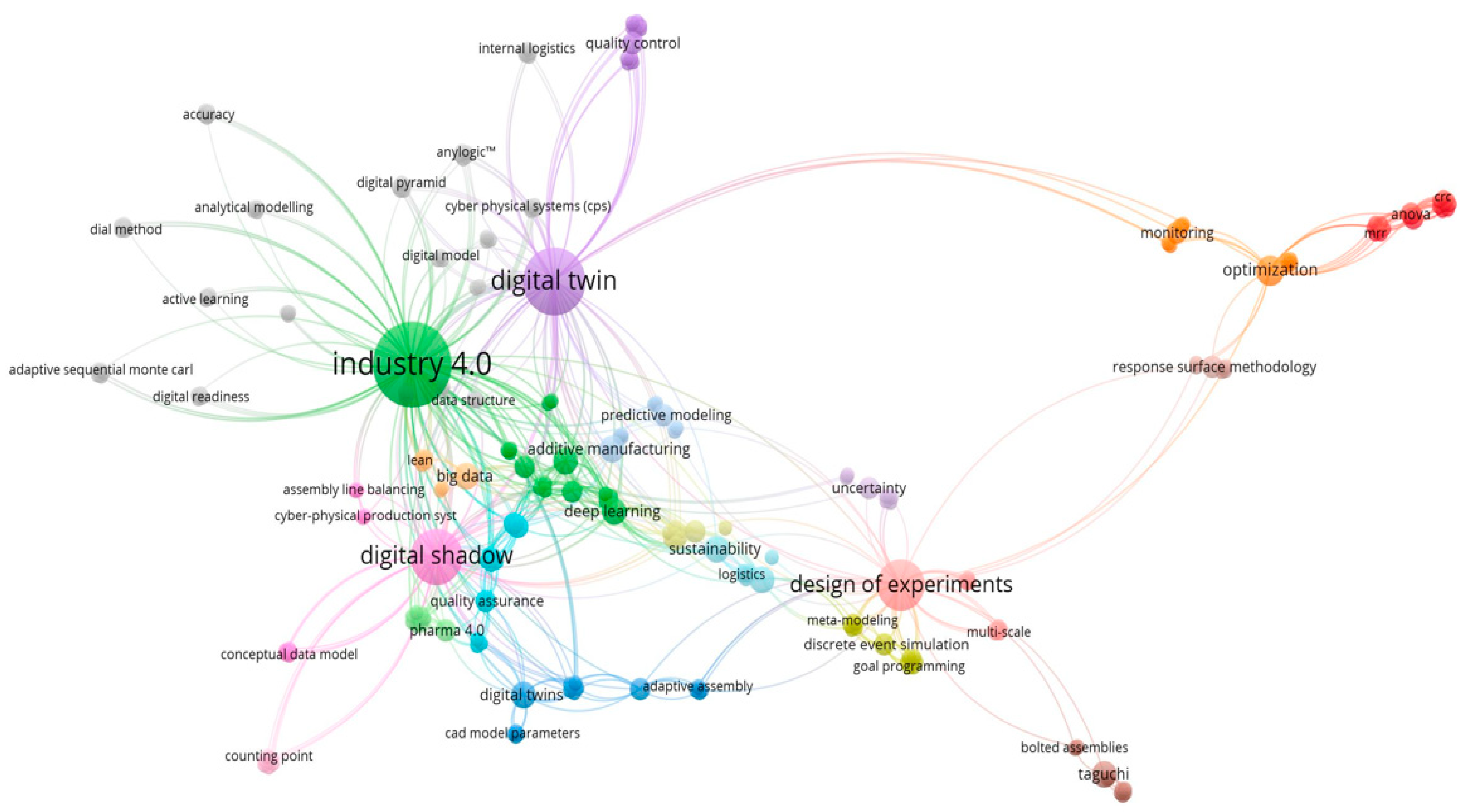
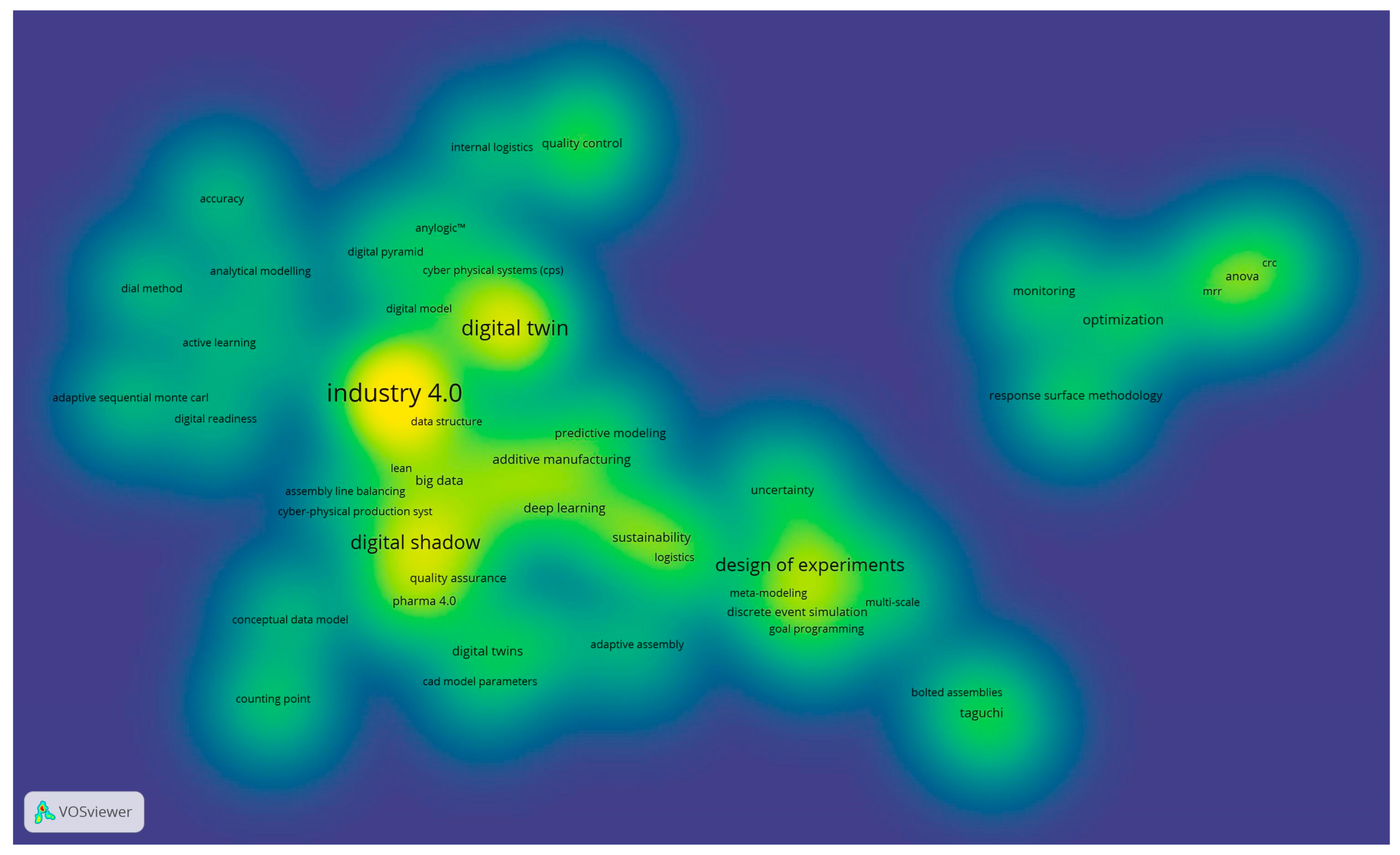
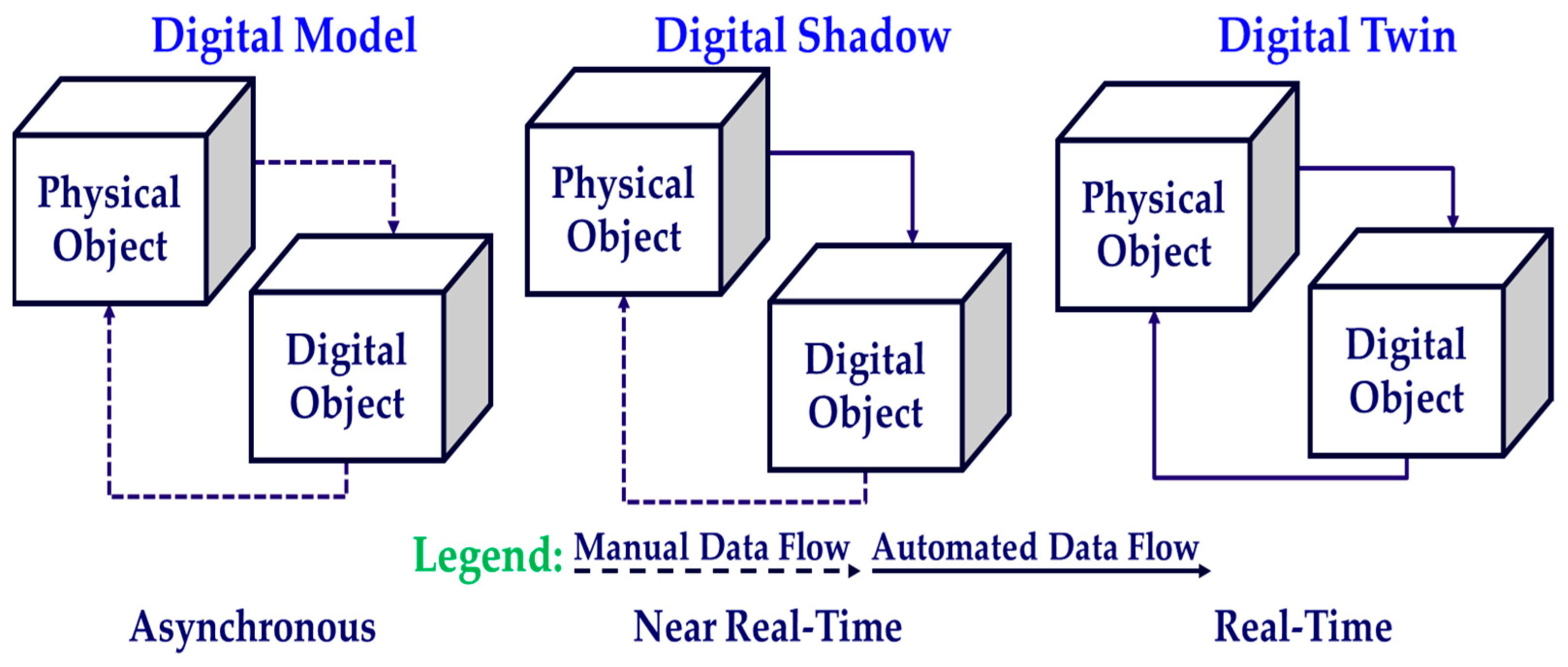
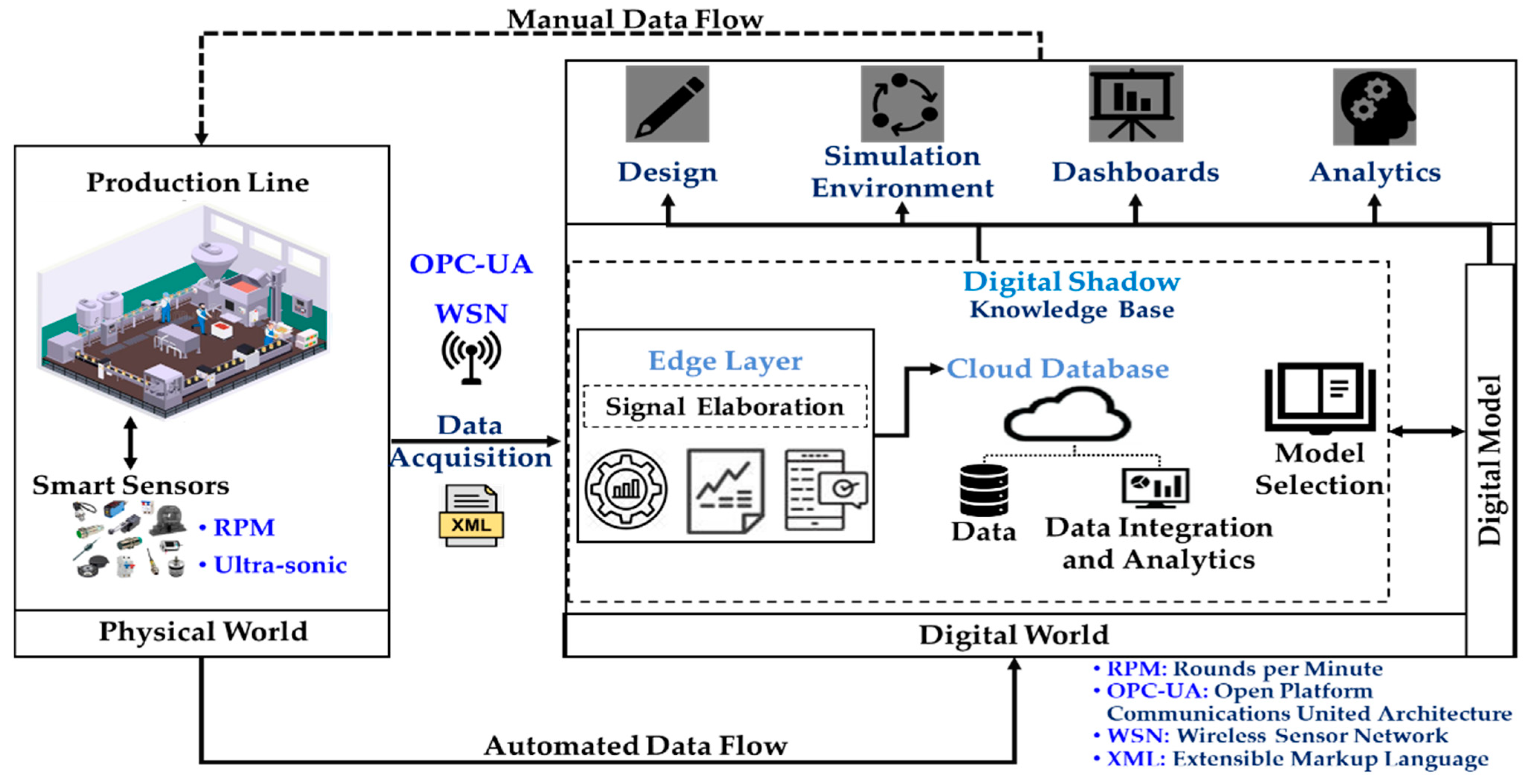
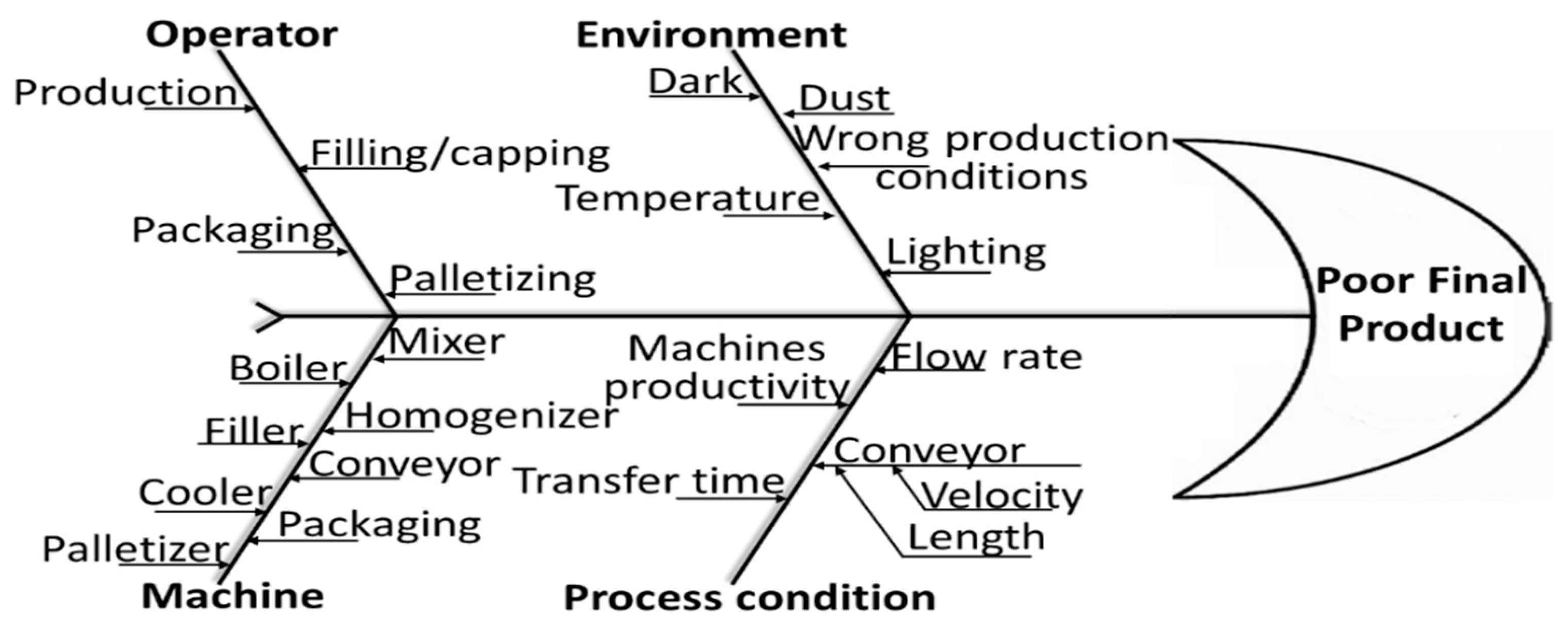

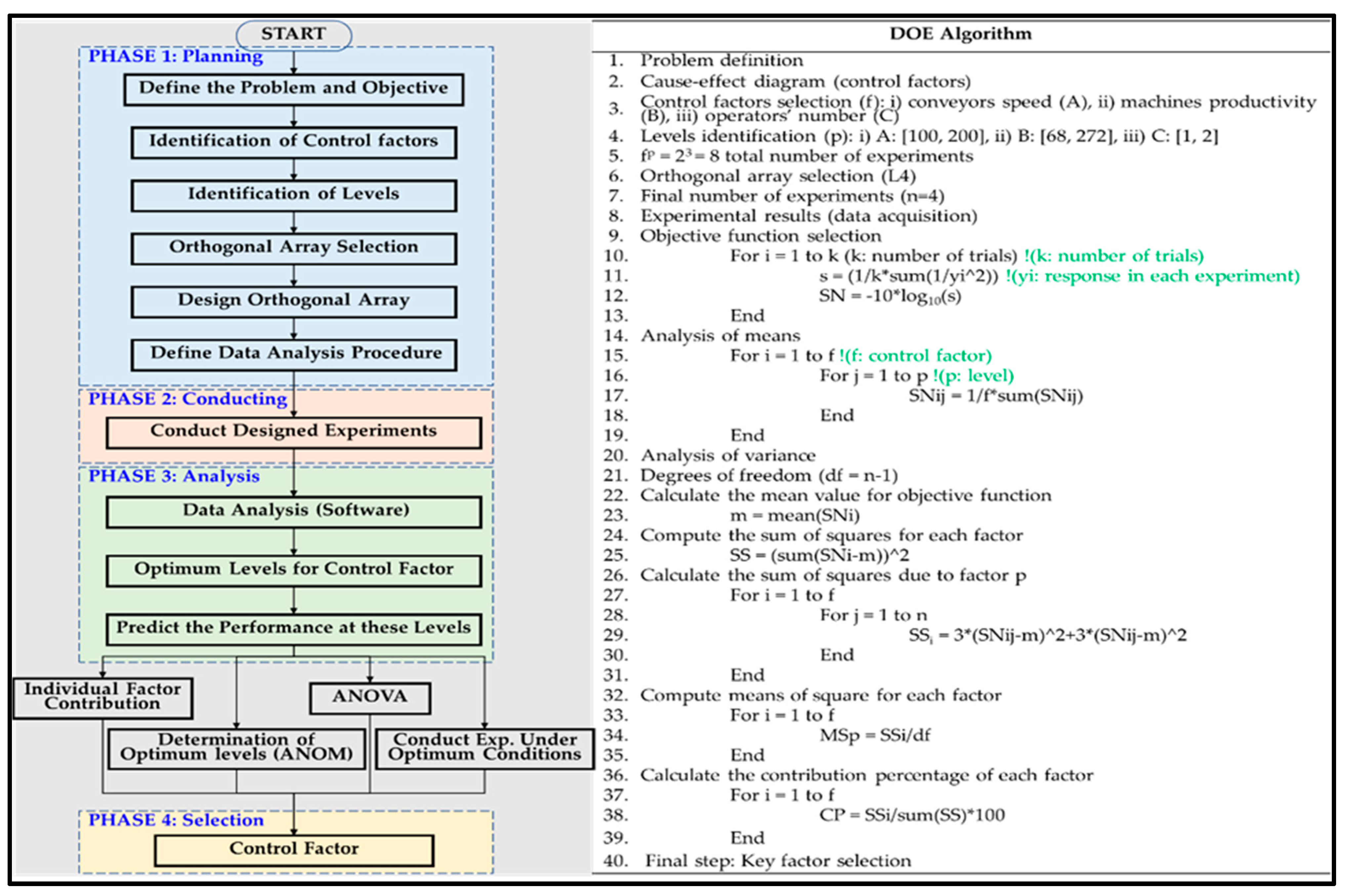

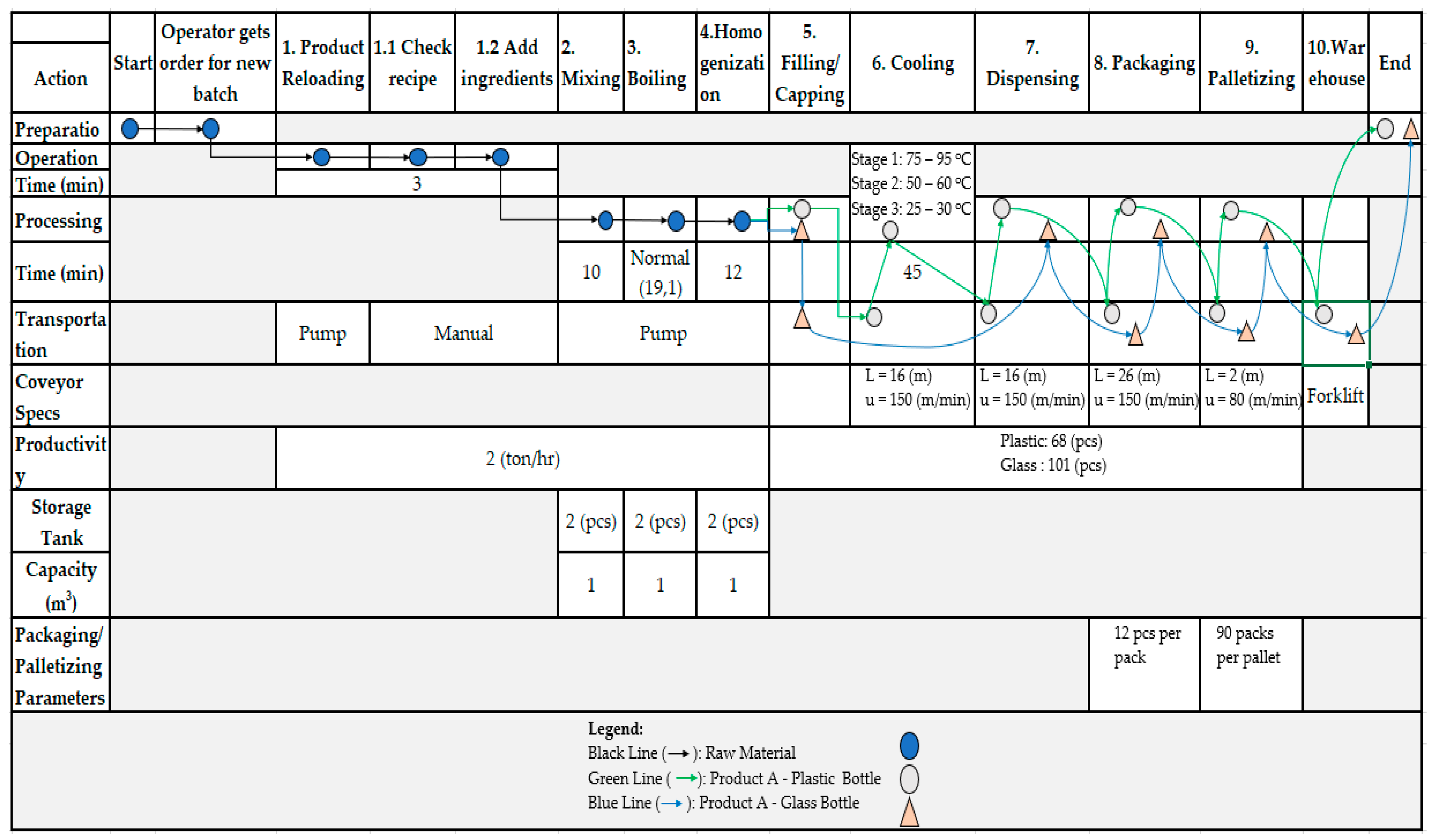


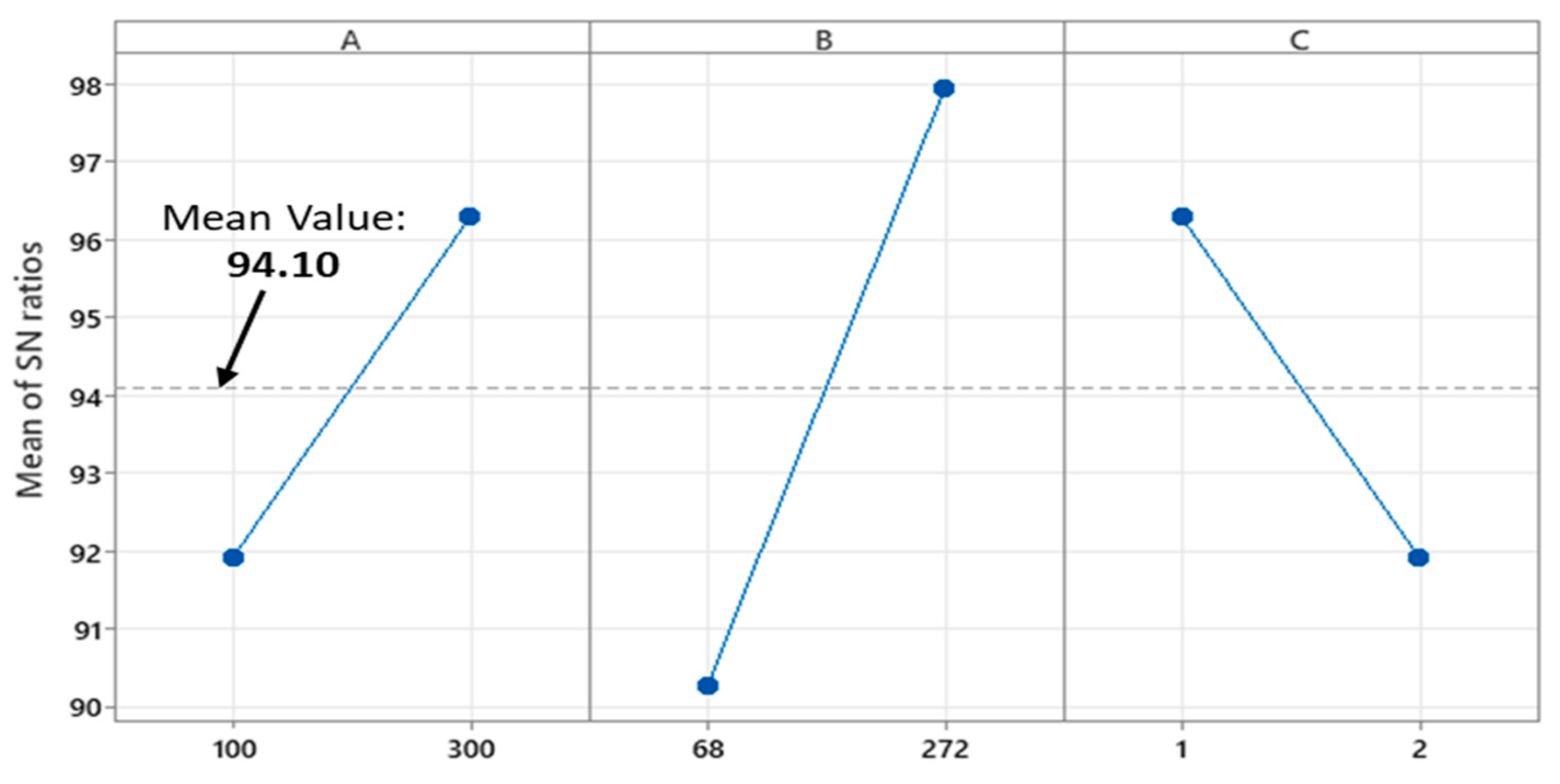

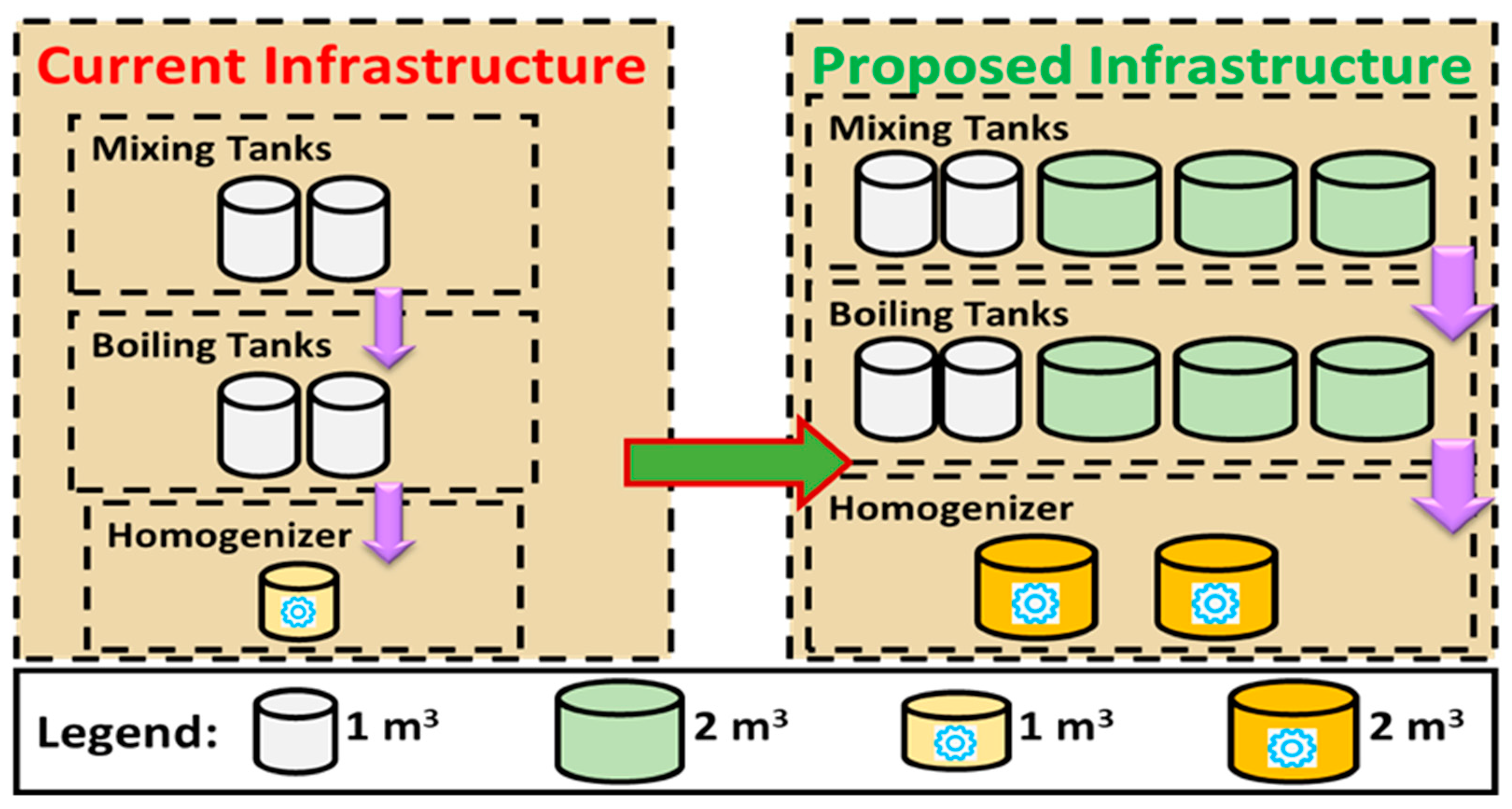
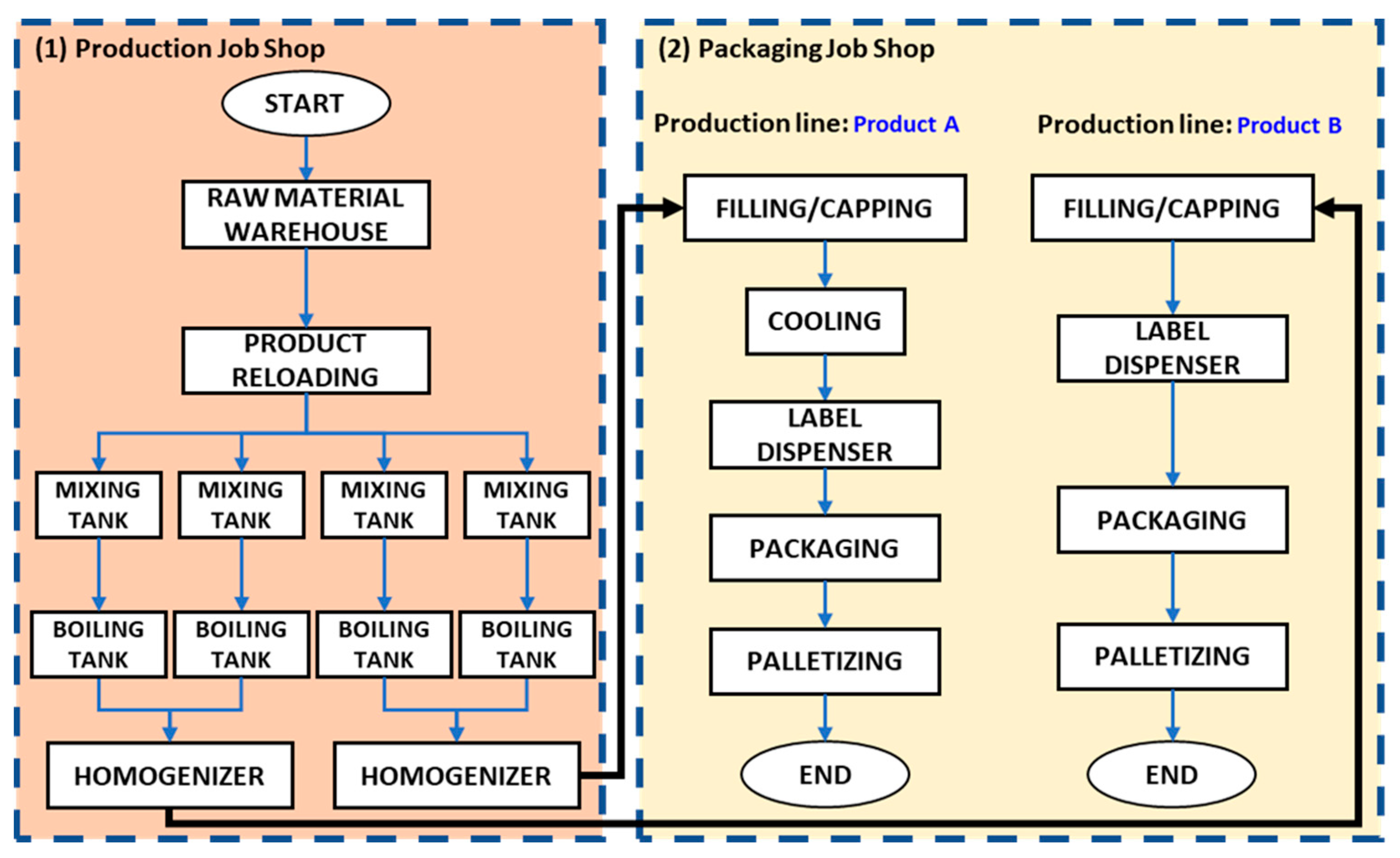
| Cluster 1 | Cluster 2 | Cluster 3 |
|---|---|---|
| Digital Twin | Assembly line balancing | Bolted assemblies |
| “as built” design | Conceptual data model | Cloud computing |
| Design for zero-defect manufacturing | Cyber-physical model | Edge computing |
| Intelligent manufacturing | Data Analytics | Fuzzy logic |
| Mesh monitoring | Digital Shadow | Load balancing |
| Quality control | Digital supply chain | Multi responses |
| ZDM mapping | Industry 4.0 | Response time |
| Life-cycle control | Mixed-model stochastic | Smart tightening |
| Smart Manufacturing | Procurement 4.0 | Taguchi |
| Criteria | Digital Model | Digital Shadow | Digital Twin |
|---|---|---|---|
| Efficiency | Identification of inefficiencies and bottlenecks virtually for process optimization | Near real-time data monitoring and analysis to identify inefficiencies and bottlenecks | Uses sensors and data analytics to create a real-time, virtual replica of a physical production system, enabling bi-directional communication |
| Quality Control | Identification of potential quality issues before implementation | Near real-time monitoring and analysis of product quality parameters | Bi-Directional near real-time monitoring of product quality, enabling process adjustments for improving quality |
| Safety | Offline identification of safety hazards before implementation | Near real-time monitoring of safety protocols & alerts for any deviations | Near real-time monitoring of safety protocols & provision of safety countermeasures |
| Real-time Data Analysis | Offline support for decision-making | Near real-time data analysis for decision-making support | Uses real-time data to provide continuous insights for decision-making and enable predictive maintenance to reduce downtime |
| Cost Savings | Simulation models can help identify cost-saving opportunities in a virtual environment before implementation | Optimized production processes and improved quality control can reduce costs | Enables optimized production processes, improved quality control, and predictive maintenance to reduce costs and increase efficiency |
| Reference | Key Contributions | Challenges—Limitations |
|---|---|---|
| [26] |
| Significant investment in:
|
| [28] |
|
|
| [29] |
| Requires specialized expertise for
|
| [34] |
|
|
| [35] |
|
|
| [36] |
|
|
| [37] |
| Requires specialized expertise for
|
| [38] |
|
|
| Reference | Contribution | Main Topics Covered | Applications and Benefits |
|---|---|---|---|
| [24] | Presents a framework for the design, modeling, and implementation of Digital Twins, and discusses their potential applications and benefits. | Design and modeling of Digital Twins.—Applications of Digital Twins in various industries, including manufacturing, healthcare, and transportation.—Benefits of using Digital Twins, such as reducing development time and cost, improving system performance, and enabling predictive maintenance. | Various industries, including manufacturing, healthcare, and transportation. Reducing development time and cost. Improving system performance. Enabling predictive maintenance. |
| [29] | Presents a conceptual framework of Digital Shadow that allow for a holistic data view on production planning and control | Design and modeling of Digital Shadow—Digital Shadow for production process and control in the injection molding | Manufacturing system (injection molding). Minimizing rejection rates in injection molding. Decisions can be made simultaneously |
| [47] | Provides a framework for designing a production system based on Digital Model technology and different simulation scenarios are evaluated using DOE | Design of manufacturing systems using Digital Model technology—Different simulation scenarios based on the DOE are studied towards the optimization of the production | Manufacturing systems (copper tube production line). Low cost, quick analysis, low risk. Improving system performance. |
| [51] | Provides an overview of the historical evolution of manufacturing systems and discusses the major trends and challenges in the field. | Historical evolution of manufacturing systems, from craft production to modern cyber-physical systems.—Major trends and challenges in the field.—Insights into the future of manufacturing, including the integration of new technologies and the need for sustainability. | Manufacturing systems. Integration of new technologies. Need for sustainability. |
| Current Manuscript | Presents a method for designing manufacturing systems based on Digital Shadow technology and robust engineering principles. | Design of manufacturing systems using Digital Shadow technology.—Implementation of robust engineering principles.—Advantages of using Digital Shadow technology and robust engineering in manufacturing systems design. | Manufacturing systems (food industry). Improving system resilience and robustness. Reducing manufacturing costs. Improving system performance. |
| Signal-to-Noise Ratio (SNR) | Goal of the Experiment | Data Characteristics | Signal-to-Noise Ratio Formulas |
|---|---|---|---|
| Larger is Better | Maximize the response | Positive | |
| Smaller is Better | Minimize the response | Non-negative with a target value of zero | |
| Nominal is Best | Target the response and you want to base the signal-to-noise ratio on standard deviations only | Positive, zero, or negative | |
| Nominal is Best (default) | Target the response and you want to base the signal-to-noise ratio on means and standard deviations | Non-negative with an “absolute zero” in which the standard deviation is zero when the mean is zero | s: variation |
| 1 | 2 | |
|---|---|---|
| A (m/min) | 100 | 300 |
| B (pcs/min) | 68 | 272 |
| C (-) | 1 | 2 |
| 2 | 3 | 4 | 5 | 6 | 7 | 8 | 9 | 10 | 11 | 12 | 13 | … | 31 | ||
| Number of Levels (p) | 2 | L4 | L4 | L8 | L8 | L8 | L12 | L12 | L12 | L12 | L12 | L16 | L12 | … | L32 |
| 3 | L9 | L9 | L9 | L18 | L18 | L18 | L18 | L27 | L27 | L27 | L27 | L27 | … | ||
| 4 | L16 | L16 | L16 | L16 | L16 | L32 | L32 | L32 | L32 | … | |||||
| 5 | L25 | L25 | L25 | L25 | L25 | L25 | L50 | L50 | L50 | L50 | L50 | … | |||
| Experiments | Conveyors Velocity (A) | Machines’ Productivity (B) | Operator Number (C) |
|---|---|---|---|
| 1 | 1 | 1 | 1 |
| 2 | 1 | 2 | 2 |
| 3 | 2 | 1 | 2 |
| 4 | 2 | 2 | 1 |
| Key Performance Indicator | Description |
|---|---|
| KPI_1 | Production Rate (quantity) of products |
| KPI_2 | Filling Machines’ Productivity |
| Simulation Time = 480 (min)—Bottle Capacity = 490 (g) | ||||
|---|---|---|---|---|
| Product | KPI_1: Quantity (ton/h) | KPI_2: Productivity (Bottles/h) | ||
| Theoretical Value | Experimental Value | Theoretical Value | Experimental Value | |
| Product A | 2 | 2 | 300 | 68 |
| Experiments | Conveyors Velocity (A) | Machines’ Productivity (B) | Operator Number (C) | |
|---|---|---|---|---|
| 1 | 100 | 68 | 1 | 32,624 |
| 2 | 100 | 272 | 2 | 47,719 |
| 3 | 300 | 68 | 2 | 32,640 |
| 4 | 300 | 272 | 1 | 130,442 |
| Experiments | Conveyors Velocity (A) | Machines’ Productivity (B) | Operator Number (C) | SN Ratio |
|---|---|---|---|---|
| 1 | 100 | 68 | 1 | 90 |
| 2 | 100 | 300 | 2 | 94 |
| 3 | 300 | 68 | 2 | 90 |
| 4 | 300 | 300 | 1 | 102 |
| Larger Is Better | Conveyors Velocity (A) | Machines’ Productivity (B) | Operator Number (C) |
|---|---|---|---|
| 1 | 91.924 | 90.270 | 96.290 |
| 2 | 96.290 | 97.940 | 91.922 |
| Rank | 2 | 1 | 3 |
| Source | Degrees of Freedom | SS | MS | Contribution Percentage |
|---|---|---|---|---|
| Conveyors Velocity (A) | 1 | 1,711,435,530 | 1,711,435,530 | 25.90% |
| Machines’ Productivity (B) | 1 | 3,186,433,152 | 3,186,433,152 | 48.20% |
| Operator Number (C) | 1 | 1,710,111,962 | 1,710,111,962 | 25.88% |
| Error | 0 | 0 | ||
| Sum | 3 | 6,607,980,645 |
| Simulation Time = 480 (min)/Bottle Capacity = 490 (g)/Product A | ||||
|---|---|---|---|---|
| A/A | KPI_1: Quantity (ton/h) | KPI_2: Productivity (Bottles/min) | ||
| Theoretical Value | Experimental Value | Theoretical Value | Experimental Value | |
| 1 | 2 | 2 | 300 | 68 |
| 2 | 4 | 4 | 136 | |
| 3 | 6 | 6 | 204 | |
| 4 | 8 | 8 | 272 | |
Disclaimer/Publisher’s Note: The statements, opinions and data contained in all publications are solely those of the individual author(s) and contributor(s) and not of MDPI and/or the editor(s). MDPI and/or the editor(s) disclaim responsibility for any injury to people or property resulting from any ideas, methods, instructions or products referred to in the content. |
© 2023 by the authors. Licensee MDPI, Basel, Switzerland. This article is an open access article distributed under the terms and conditions of the Creative Commons Attribution (CC BY) license (https://creativecommons.org/licenses/by/4.0/).
Share and Cite
Mourtzis, D.; Balkamos, N. Design of Manufacturing Systems Based on Digital Shadow and Robust Engineering. Appl. Sci. 2023, 13, 5184. https://doi.org/10.3390/app13085184
Mourtzis D, Balkamos N. Design of Manufacturing Systems Based on Digital Shadow and Robust Engineering. Applied Sciences. 2023; 13(8):5184. https://doi.org/10.3390/app13085184
Chicago/Turabian StyleMourtzis, Dimitris, and Nikos Balkamos. 2023. "Design of Manufacturing Systems Based on Digital Shadow and Robust Engineering" Applied Sciences 13, no. 8: 5184. https://doi.org/10.3390/app13085184









